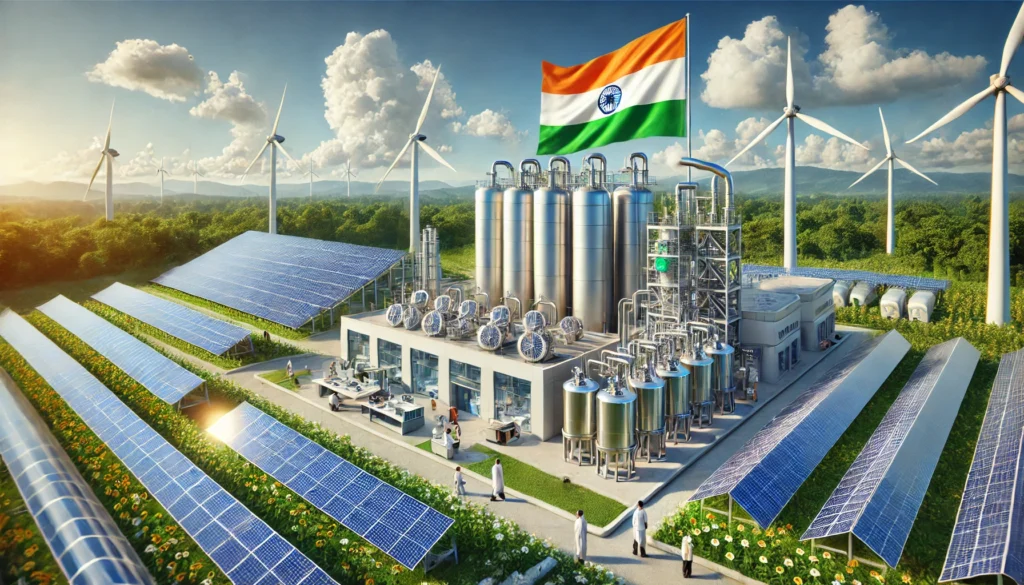Introduction:
India is making significant strides toward establishing itself as a leader in green hydrogen production, aligning with its ambitious goals of achieving carbon neutrality and reducing dependence on fossil fuels. Green hydrogen, produced by splitting water into hydrogen and oxygen using renewable energy, offers a clean and efficient energy source, especially for sectors like transportation, industry, and electricity. Here’s a closer look at India’s latest green hydrogen initiatives and how they’re setting the country on a sustainable path forward.

What Is Green Hydrogen?
Green hydrogen is a renewable form of hydrogen generated by using renewable electricity sources like solar and wind power. Unlike grey hydrogen, produced using fossil fuels and releasing carbon emissions, green hydrogen emits no greenhouse gases, making it an ideal energy source for combating climate change. India’s interest in green hydrogen stems from its potential to decarbonize various industries and contribute to the country’s energy security.
India’s Green Hydrogen Mission
The Indian government launched the National Hydrogen Mission with the aim of making India a global hub for green hydrogen production and export. This mission seeks to produce 5 million metric tonnes of green hydrogen by 2030, supported by a series of policy measures, incentives, and partnerships with the private sector. The mission promotes investment, research, and collaboration to ensure India’s position as a competitive green hydrogen producer.
Key Initiatives and Investments
Several recent initiatives reflect India’s dedication to green hydrogen. The government has allocated a substantial budget to support green hydrogen projects, and public-sector companies such as NTPC, Indian Oil, and ONGC are actively participating in pilot projects for green hydrogen production and storage. Leading private sector players like Reliance Industries and Adani Group have also committed to significant investments in green hydrogen, which will drive large-scale production and bring down costs over time.
Advantages of Green Hydrogen for India
- Reducing Emissions: Green hydrogen can replace fossil fuels in high-emission sectors, helping India reduce its carbon footprint and align with the Paris Agreement targets.
- Energy Security: By producing green hydrogen domestically, India can lessen its reliance on imported fossil fuels, enhancing its energy independence.
- Economic Growth and Job Creation: The development of a green hydrogen economy could create millions of jobs across manufacturing, research, and development sectors, boosting local economies.
- International Collaboration: India’s green hydrogen initiatives also open doors for collaborations with other countries, including Japan and Germany, which are investing heavily in hydrogen technology.
Challenges Ahead
While the potential is significant, India faces several challenges in its green hydrogen journey. The high cost of electrolyzers (devices that split water to produce hydrogen) and limited infrastructure for hydrogen storage and transport are major hurdles. Moreover, scaling renewable energy sources to meet the demands of green hydrogen production is essential, requiring sustained investment and regulatory support.
Conclusion:
India’s green hydrogen initiatives represent a transformative step toward a sustainable, low-carbon future. By fostering innovation, encouraging public-private partnerships, and investing in infrastructure, India is poised to become a global leader in green hydrogen production. As the nation builds on these initiatives, green hydrogen may soon become a cornerstone of India’s energy landscape, driving environmental sustainability and economic growth. With sustained commitment, India’s leap into green hydrogen could set an example for other developing nations aiming to achieve clean energy targets.
भारत की हरित हाइड्रोजन की नई पहल: एक सतत भविष्य की ओर कदम
प्रस्तावना:
भारत हरित हाइड्रोजन उत्पादन में वैश्विक नेता बनने की दिशा में महत्वपूर्ण कदम उठा रहा है। इस क्षेत्र में अग्रसर होकर देश कार्बन तटस्थता और जीवाश्म ईंधनों पर निर्भरता कम करने के अपने महत्वाकांक्षी लक्ष्यों को पूरा कर रहा है। हरित हाइड्रोजन, जिसे नवीकरणीय ऊर्जा द्वारा जल को हाइड्रोजन और ऑक्सीजन में विभाजित करके तैयार किया जाता है, परिवहन, उद्योग और बिजली क्षेत्रों के लिए एक स्वच्छ और प्रभावी ऊर्जा स्रोत प्रदान करता है। आइए भारत की हरित हाइड्रोजन में हालिया पहलों और देश को सतत भविष्य की दिशा में ले जाने के इनके योगदान पर नजर डालें।

हरित हाइड्रोजन क्या है?
हरित हाइड्रोजन एक नवीकरणीय हाइड्रोजन का प्रकार है जो सौर और पवन ऊर्जा जैसी नवीकरणीय बिजली स्रोतों का उपयोग करके उत्पन्न किया जाता है। यह जीवाश्म ईंधन से उत्पन्न होने वाले ग्रे हाइड्रोजन से अलग है क्योंकि इससे ग्रीनहाउस गैसों का उत्सर्जन नहीं होता है। भारत की हरित हाइड्रोजन में रुचि इस तथ्य पर आधारित है कि यह विभिन्न उद्योगों का डीकार्बोनाइजेशन कर सकता है और देश की ऊर्जा सुरक्षा में योगदान दे सकता है।
भारत का हरित हाइड्रोजन मिशन
भारत सरकार ने राष्ट्रीय हाइड्रोजन मिशन की शुरुआत की है ताकि देश को हरित हाइड्रोजन उत्पादन और निर्यात का एक वैश्विक केंद्र बनाया जा सके। इसका उद्देश्य 2030 तक 5 मिलियन मीट्रिक टन हरित हाइड्रोजन उत्पादन का लक्ष्य निर्धारित करना है।
हरित हाइड्रोजन के भारत के लिए फायदे
- उत्सर्जन कम करना: हरित हाइड्रोजन जीवाश्म ईंधन की जगह ले सकता है।
- ऊर्जा सुरक्षा: भारत की ऊर्जा आत्मनिर्भरता को बढ़ा सकता है।
- आर्थिक विकास और रोजगार: हरित हाइड्रोजन क्षेत्र में लाखों रोजगार का सृजन होगा।
- अंतर्राष्ट्रीय सहयोग: जापान और जर्मनी जैसे देशों के साथ सहयोग के द्वार खुलेंगे।
निष्कर्ष:
हरित हाइड्रोजन में भारत की पहल एक सतत, कम-कार्बन भविष्य की दिशा में एक महत्वपूर्ण कदम है।
Follow my website for more interesting and insightful blogs!
